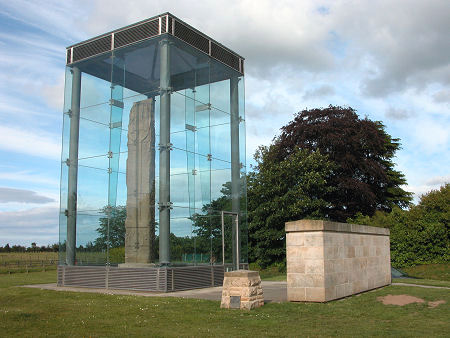
Best viewed in
Internet Explorer
PDF
Back to

Updated
07/08/2013 |
Sueno's Stone

Sueno's Stone is the largest and most spectacular of the many carved
stones that have survived from the early medieval period in Scotland. It
stands in a purpose built glass shelter on the north eastern edge of the
town of Forres.
The most striking thing
about Sueno's Stone is its enormous scale. It stands over 21ft high and
carries intricate carving that completely covers the front and rear
faces of the stone, and its sides. The western or front side of the
stone carries a huge ring headed cross, the body and surrounds of which
have been filled with interlaced knotwork designs. The base of the cross
is a few feet above the base of the stone, and the gap beneath it
carries carvings of two bearded figures facing one another, with a
smaller figure between them and others behind them.

 |
The rear or
eastern side of the stone is very different. Here you are
confronted with what amounts to a Bayeux Tapestry in stone:
an account of a battle told in a series of horizontal strips
set within panels which are displayed one above another down
the length of the stone. Similar techniques have been used
elsewhere, especially on the Pictish symbol stone at
Aberlemno Kirk, but it is the sheer scale of the battle
being depicted, and the scale of the stone that has
resulted, that makes Sueno's Stone unique.
The uppermost
panel shows nine mounted warriors in three lines and has
been interpreted as showing a leader arriving for battle
with his personal escort. The second panel shows two lines
of warriors on foot, the lower line apparently in the midst
of combat, with those on the left turning to flee,
signifying defeat. The next strip within the panel shows
warriors besieging a broch, while on the left is a pile of
headless corpses, whose detached heads are depicted in front
of the broch. The final strip in this panel shows a scene in
which warriors on foot are routing mounted warriors.
The third
panel shows another pile of corpses underneath a curved
object, by one interpretation a bridge. One element of this
panel is thought to depict the defeated chieftain, again
without a head, while the bottom strip shows more of the
enemy running away. As one commentator wrote:
"This is war reporting on a
monumentally self-confident scale".
Opinions
differ about which battle the stone is meant to depict. Some
say it represents the defeat of the Picts by the Scots of
Dalriada under Kenneth Mac Alpin in 841, which would mean it
was not actually a "Pictish" symbol stone: as histories are
always written by the victors. For the philosopher Hector
Boece, writing in the 1520s, the stone signified a battle
involving the forces of the Norse King Swein Forkbeard (or "Sueno")
against Scots. Other theories involve more historically
likely encounters between Norse and Picts or Norse and
Scots, and the battle known to have been fought at Forres in
966 in which King Duff or "Dubh" of Alba fought for control
over Moray.
Duff was
subsequently murdered and his body hidden under a bridge at
nearby Kinloss. If you subscribe to this theory then the
arched structure shown on the stone is the bridge under
which Duff's body was hidden. The truth, of course, is that
no-one really knows which battle the stone depicts, but
trying to guess is half the fun. |
The slab used to make
Sueno's Stone weighs over seven tons and was probably quarried at
Covesea, on the coast 11 miles to the north east. It could have been
brought most of the way to its current site by boat. Most
commentators agree that the stone is standing close to its original
location, though it has been suggested that it might originally have
been one of a pair, perhaps flanking some ceremonial entrance. The
main source for this theory is a map of Moray drawn by Timothy Pont
in the 1590s. This shows, quite clearly, two pillars standing just
to the north of Forres.
Or Pont may simply
have been mistaken. Either way, it seems that Sueno's Stone fell or
was pushed over at some time, perhaps in the 1600s, and became
buried. It was only uncovered again in the early 1700s, before being
re-erected near where it had been found. The Victorians protected
the stone with iron railings and a cap made of lead sheeting, and in
the 1990s full protection was afforded by the glass box in which the
stone now stands. This can make photography awkward, but it does
ensure that the stone will still be here for future generations to
enjoy.
Meanwhile, of course,
the thought that the other half of a matching pair may still be
waiting to be unearthed somewhere nearby is an intriguing one.
|



